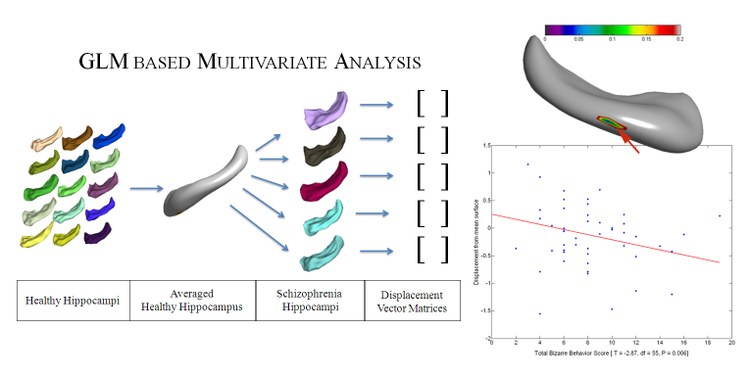Studying Brain & Behavior in Schizophrenia: Multivariate Surface Analysis of Hippocampus
Sunil Kalmady (Department of Psychiatry, National Institute of Mental Health and Neuro Sciences, Bangalore, Karnataka, India), Ganesan Venkatasubramanian (Department of Psychiatry, National Institute of Mental Health and Neuro Sciences, Bangalore, Karnataka, India), Rashmi Arasappa (Department of Psychiatry, National Institute of Mental Health and Neuro Sciences, Bangalore, Karnataka, India), S Gautham (Department of Psychiatry, National Institute of Mental Health and Neuro Sciences, Bangalore, Karnataka, India), Naren P Rao (Department of Psychiatry, National Institute of Mental Health and Neuro Sciences, Bangalore, Karnataka, India), Rishikesh Behere (Department of Psychiatry, National Institute of Mental Health and Neuro Sciences, Bangalore, Karnataka, India), B N Gangadhar (Department of Psychiatry, National Institute of Mental Health and Neuro Sciences, Bangalore, Karnataka, India)
Background: Hippocampus is one of the brain structures consistently shown to be altered in Schizophrenia, but its role in genesis of psychopathology is not well understood. Hippocampal deficits might be closely associated bizarre behaviors which form an important component of schizophrenia symptomatology. Such a hypothesis arises from robust evidence which comes from schedule-induced behavior or incentive-conditioned behavior models in animal studies wherein, such behaviors are augmented by hippocampal lesion. However, in humans, whether hippocampal deficits underlie bizarre behavior remains largely unexplored, especially in context of Schizophrenia. This study examined the hippocampal volume as well as shape using multivariate surface analysis based on linear mixed effects models & random field theory to study abnormalities in this brain structure and its relationship with severity of bizarre behavior in antipsychotic-naïve schizophrenia patients.
Methods: Using 3 Tesla - MRI (Philips Achieva), we examined antipsychotic-naïve schizophrenia patients (N=57; M:F–30:27] in comparison with healthy controls [N=56; M:F–30:26] group matched on age, sex, handedness & education. Hippocampus with Anterior & Posterior subdivisions were manually segmented by blinded raters with good inter-rater reliability [ICC>0.85] using a valid method. ‘ShapeAnalysisMANCOVA’ tool was used for statistical shape analysis based on a parametric boundary description; subsequently, surface data analysis was carried out using ‘SurfStat’ matlab toolbox. Patients were scored for bizarre behavior using Scales for Assessment of Positive Symptoms (SAPS), which accounts for following components - oddities of clothing & appearance, peculiar social & sexual behavior, aggressiveness & agitation, repetition or stereotypy, and global rating of severity of these symptoms.
Results: Patients had significant volume deficit in anterior region of both left (F=6.29, p=0.01) as well as right hippocampus (F=11.09, p=0.001) after controlling for the potential confounding effects of age, sex and intracranial volume. Shape analysis revealed significant deformities in both anterior as well as posterior hippocampal subdivision (p<0.05). Right anterior hippocampal volume had a significant negative correlation with bizarre behavior score (r=-0.38, p=0.003). Further, shape abnormalities localized to lateral region of right hippocampus had a significant positive correlation with bizarre behavior score (df=55, T max=5.15, corrected p=0.03) [i.e. the higher the score the higher was the inward displacement of hippocampal surface especially at this sub-region].
Conclusions: These first time observations examining a large sample of antipsychotic naïve Schizophrenia support the role for hippocampal volume and shape abnormalities to underlie the pathogenesis of bizarre behavioral symptoms in schizophrenia. The implication of anterior hippocampus is in tune with the existing neural basis for psychosis. Vertex based shape analysis helps to localize the volume changes within hippocampal structure, thereby providing useful insights into probable changes in cytoarchitecture. This study demonstrates successful application of a neuroinformatic approach like multivariate surface analysis of brain structure to better understand the role of structural brain abnormalities in clinical manifestation of a neuropsychiatric disorder.
Acknowledgement: This study was supported by Innovative Young Biotechnologist Award by the Department of Biotechnology (Government of India) to GV.


 Latest news for Neuroinformatics 2011
Latest news for Neuroinformatics 2011 Follow INCF on Twitter
Follow INCF on Twitter
